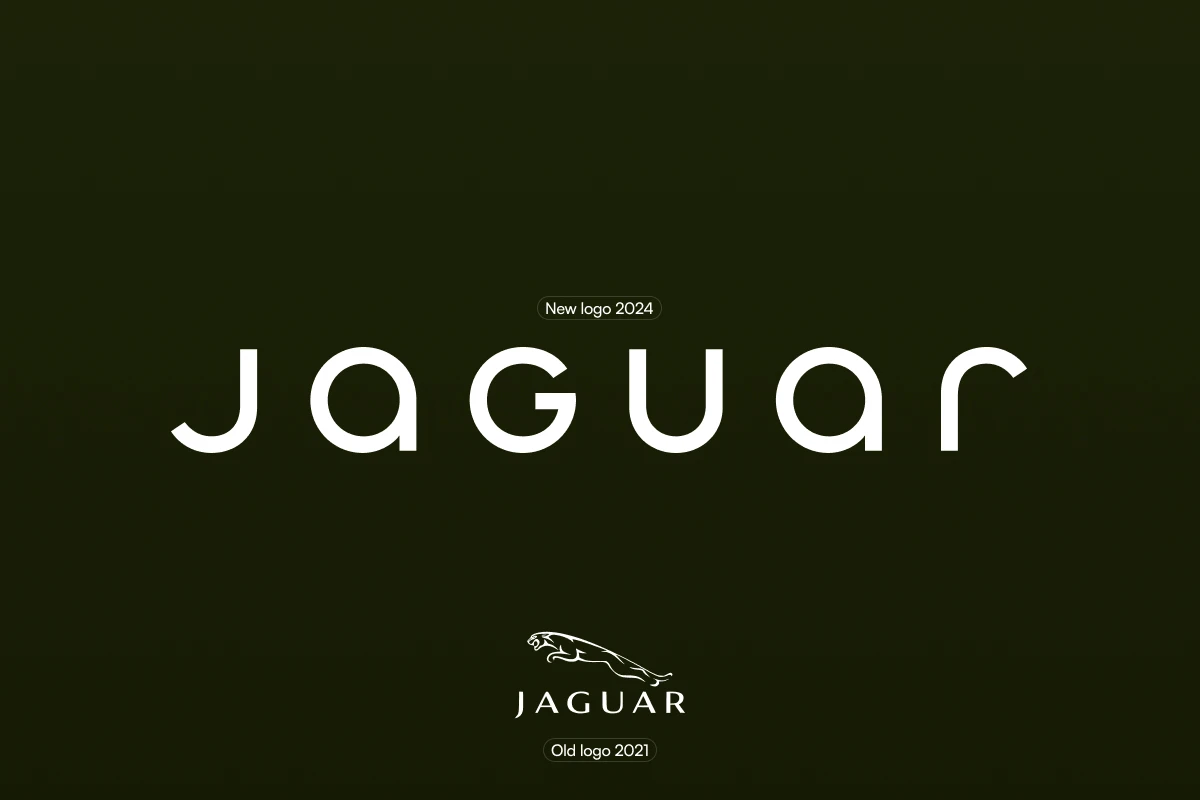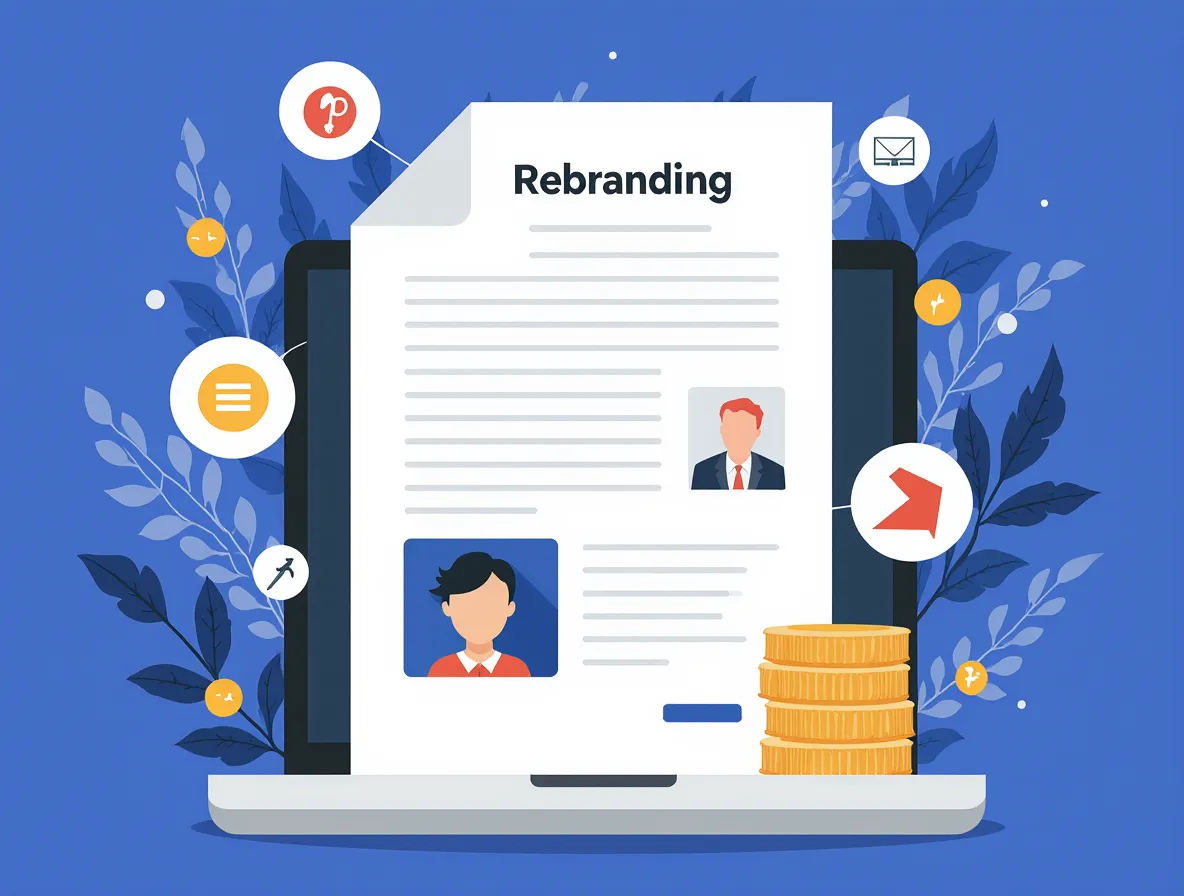Rebranding is a strategic business transformation that can revitalize your market position, attract new customers, and breathe fresh life into your company. Done correctly, rebranding your business increases revenue by 20-30% within the first year.
Once the rebranding is complete, it is important to properly integrate the new identity into all aspects of the business. These materials will help you get the most out of your investment in the updated brand:
- Rebranding Strategies: How to Build a Successful Path
- Rebranding vs. Brand Refresh: How to Choose the Right Scale of Change
- How to Rebrand a Small Business: Complete Guide for Entrepreneurs
What Is Rebranding and Why Does It Matter?
Rebranding is the comprehensive process of changing your company's corporate identity, positioning, and messaging to better align with your business goals and market demands. This transformation addresses three core areas: visual identity, brand messaging, and customer experience.
Visual identity includes logos, colors, typography, and design systems. Brand messaging encompasses brand voice, values, positioning statements, and communication frameworks. Customer experience covers touchpoints, service delivery, digital interfaces, and interaction protocols.
Companies typically rebrand for market expansion, competitive differentiation, reputation recovery, or business evolution. Market research shows that 73% of successful rebranding initiatives stem from specific business drivers rather than aesthetic preferences.
{{vad-quote-1}}
Why Do Companies Rebrand? Key Drivers Behind Brand Renewal
Companies don't rebrand on impulse. Strategic rebranding responds to measurable business pressures and opportunities that demand brand evolution.
- Market evolution drives 40% of rebranding decisions. Customer preferences shift faster than brand adaptation, creating perception gaps that hurt business performance. Technology disruption forces traditional companies to modernize their image to maintain market relevance.
- Mergers and acquisitions create immediate rebranding needs. Combining different brand identities under one cohesive umbrella requires strategic planning and careful execution to preserve valuable brand equity from both organizations.
- Reputation challenges trigger defensive rebranding strategies. Negative associations that stick to current brands necessitate fresh starts through strategic brand renewal.
- Geographic expansion often requires adaptation of messaging and visuals for new cultural contexts and market expectations.
Competition intensity increases rebranding frequency. Outdated brands lose market share to nimble startups and modernized competitors. Strategic rebranding helps established companies reclaim competitive positioning and market leadership.
When Should You Consider Rebranding Your Business?
Your brand needs renewal when customer perception diverges from your business reality. This disconnect manifests in declining sales, reduced customer engagement, or difficulty attracting target demographics.
Warning signs include outdated visual elements that make your company appear behind current market standards. Messaging that fails to resonate with your audience creates communication barriers that hurt conversion rates. Brand identity that limits growth potential constrains business expansion and market penetration.
Financial indicators signal rebranding necessity. Declining market share, reduced customer lifetime value (LTV), or difficulty commanding premium prices often stem from brand perception issues that strategic renewal can address effectively.
Internal factors matter equally. Teams that struggle to explain company positioning face customer communication challenges. Recruitment difficulties due to brand perception problems indicate broader market positioning issues that rebranding can resolve.
The Psychology of Successful Rebranding
Successful rebranding leverages psychological principles that influence customer behavior, decision-making processes, and brand perception formation.
The mere exposure effect explains why gradual brand introductions often outperform sudden dramatic changes. Customers develop preferences for familiar stimuli, making abrupt shifts potentially jarring and counterproductive to business goals.

Cognitive dissonance theory suggests major brand changes create mental discomfort in existing customers who have established relationships with previous brand identities. Smart rebranding strategies acknowledge this psychological challenge and provide clear narratives that help customers reconcile changes with existing perceptions and emotional connections.
Social proof becomes crucial during rebranding transitions. Customers look to others for validation when brands change significantly. Testimonials, case studies, and early adopter success stories help overcome natural resistance to new brand identities and positioning changes.
Color psychology plays significant roles in brand perception formation. Blue conveys trust and stability, while red suggests energy and urgency in customer minds. Understanding these deep associations helps designers create visual identities that support strategic positioning goals rather than working against them.
The anchoring effect influences how customers perceive brand changes over time. First impressions of new brands become reference points for all future interactions, making launch execution absolutely critical for long-term success and market acceptance.
How to Rebrand a Company Step by Step: Complete Framework
Successful rebranding follows structured approaches that minimize risks while maximizing impact. Here's how to successfully rebrand your organization:
Phase 1: Discovery and Research
Comprehensive brand audits analyze current brand performance, customer perceptions, and competitive landscape positioning. Customer surveys with existing clients, lost prospects, and internal stakeholders reveal perception gaps that drive strategic decisions.
Market research identifies positioning opportunities and reveals trends that should influence new brand direction. This phase establishes a strategic foundation for all subsequent tactical decisions.
Phase 2: Strategy Development
Define new brand positioning, personality frameworks, and value proposition architecture. Create detailed buyer personas for target audiences and map comprehensive customer journey touchpoints.
Develop key messaging frameworks that guide all future communications. Brand guidelines serve as blueprints for design and implementation decisions, ensuring consistency across all customer touchpoints.
Phase 3: Creative Development
Design new visual identity systems including logo variations, color palettes, typography hierarchies, and imagery style guidelines. Create comprehensive brand guidelines that specify element usage across different applications and contexts.
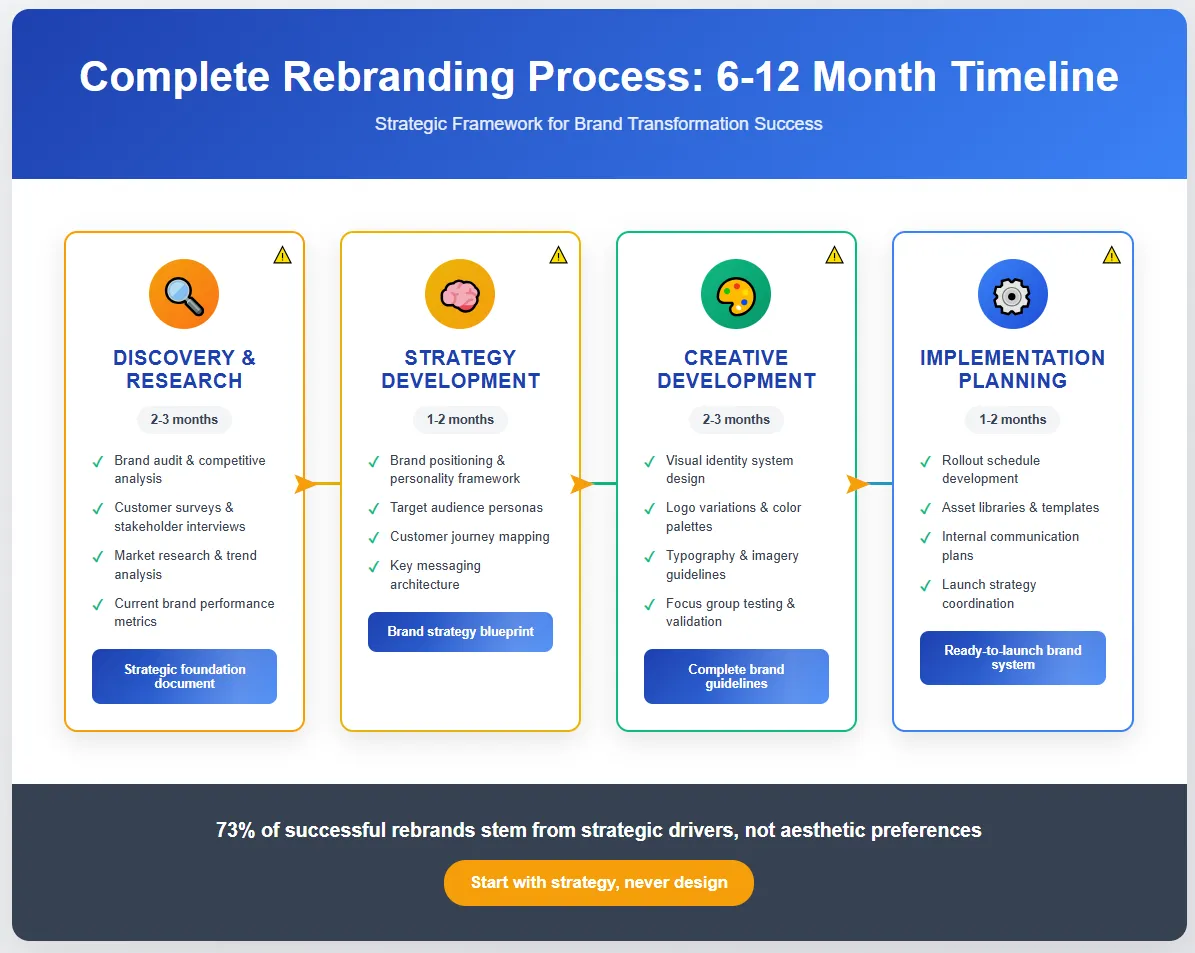
Test creative concepts with focus groups or online surveys to validate market effectiveness before final approval. This prevents costly implementation mistakes and ensures strong market resonance.
Phase 4: Implementation Planning
Develop detailed rollout schedules for all brand touchpoints. Prioritize high-impact elements: websites, business cards, signage, and digital properties. Plan internal communications to prepare teams for transition periods.
Create asset libraries and template systems that make brand applications consistent and efficient across organizations. Consider the logistics of updating everything from business cards to vehicle wraps and facility signage.
If you recognize your company in the scenarios described above and are ready for a strategic brand refresh, our rebranding services will help you navigate the entire process from analysis to successful launch. We specialize in comprehensive projects where every decision is based on a deep understanding of your business and market. Learn more about our rebranding agency.
Most Common Rebranding Mistakes and How to Avoid Them
Mistake 1: Changing Everything Simultaneously Without Testing
Many business owners get excited about new brands and rush implementation across all touchpoints simultaneously. This approach seems logical because it creates immediate visual impact and appears professional to external audiences.
The cost of this mistake is enormous. Simultaneous changes prevent measurement of individual element effectiveness. Negative customer reactions after full commitment require expensive reversals or modifications. A software company spent $200,000 updating all materials, only to discover their new brand confused existing customers and reduced conversion rates by 35%. They spent another $150,000 partially reverting changes.
Mistake 2: Focusing Only on Visual Elements While Ignoring Brand Strategy
Business owners often treat rebranding as design projects, concentrating on modern, attractive visual elements. This approach feels productive because tangible design results provide immediate satisfaction and visible progress indicators.
This mistake costs strategic positioning and competitive advantage. Beautiful logos without clear brand positioning become expensive decorations that fail to drive business results. A consulting firm spent $50,000 on stunning visuals but maintained confused messaging. Despite beautiful design, they continued struggling to communicate value propositions. Client acquisition remained difficult because prospects couldn't differentiate them from competitors.
Mistake 3: Excluding Employees from the Rebranding Process
Leadership teams often develop new brands in isolation, planning to reveal changes to employees after finalization. This top-down approach seems efficient and maintains creative control throughout development processes.
Employee disconnect destroys rebranding effectiveness from internal operations outward. Teams that don't understand or believe in new brands cannot authentically represent them to customers. A retail chain spent months developing a customer-first brand but never explained strategy to frontline staff. Employees continued using old talking points and couldn't answer customer questions about changes. Customer satisfaction scores dropped 15% during transition periods because experiences didn't match brand promises.
Think of rebranding as changing business DNA, never just appearance. Every employee needs to understand and embody new brands for success.
Brand Refresh vs. Complete Rebrand: What's the Difference?
For a deeper look at what a brand refresh includes — with examples, timelines, and budgets — check our detailed guide. The difference lies in scope, investment requirements, and strategic impact levels.
Brand refresh works when core strategy remains solid but execution needs updating. Complete rebranding becomes necessary when fundamental business changes require new market positioning and customer perception shifts.
Building Your Rebranding Budget: Investment Expectations
Rebranding costs vary dramatically based on scope, company size, and execution complexity requirements. Small businesses typically invest $25,000-$100,000, while large corporations may spend millions on comprehensive transformations.
Design and strategy development consumes 40-50% of total budgets. Professional brand strategy and creative development form the largest expense categories, including research, strategy development, logo design, brand guidelines, and initial marketing materials.
- Implementation and rollout requires 30-40% of budgets. Updating all brand touchpoints demands significant investment in website redesign, signage, business materials, packaging, and digital asset creation across all customer touchpoints.
- Marketing and communication efforts consume 15-25% of budgets. Launch campaigns, internal communications, and customer education ensure smooth transitions while protecting customer relationships during change periods.
- Contingency and optimization reserves should represent 10-15% of total budgets. Unexpected challenges always arise during rebranding projects. Smart budget planning includes funds for additional testing, minor revisions, and unforeseen implementation requirements.
Digital Rebranding: Updating Your Online Presence
Digital rebranding has become crucial as online presence serves as the primary brand touchpoint for most businesses. Websites, social media platforms, and digital marketing materials provide customers' first brand impressions in 80% of business interactions.
Website redesign typically leads digital rebranding efforts. New visual identity, messaging frameworks, and user experience design must align perfectly with brand strategy. Plan for 6-8 weeks of development time and comprehensive testing across all devices, browsers, and user scenarios.

Social media presents unique implementation challenges. Changing handles, updating profiles, and maintaining engagement during transitions requires careful coordination and timing. Create content that explains rebrand stories and helps followers understand changes without losing connection.
Search engine optimization needs special attention during digital rebranding. URL changes, content updates, and new messaging can impact search rankings significantly. Work with SEO professionals to minimize traffic disruption and maintain organic visibility throughout transitions.
{{vad-quote-2}}
How to Do a Successful Rebranding: Measuring Success
Effective measurement starts before beginning rebranding projects. Establish baseline metrics for brand awareness, perception scores, customer acquisition costs (CAC), and revenue performance indicators.
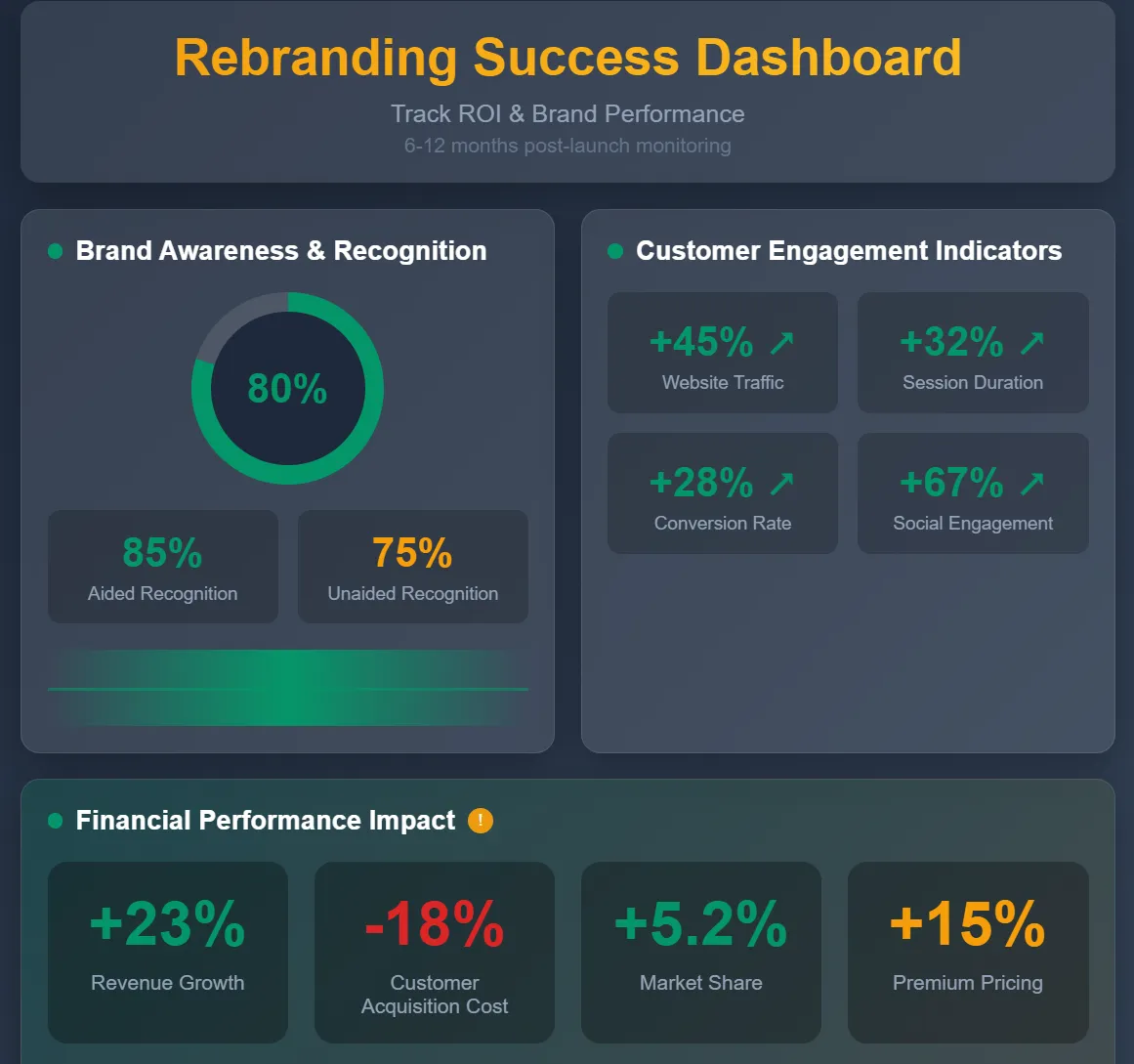
Brand recognition metrics track aided and unaided brand recognition through customer surveys and market research. Measure how quickly customers and prospects recognize new brand elements across different touchpoints. Successful rebranding achieves 80%+ recognition within six months of launch completion.
- Customer engagement indicators monitor website traffic, session duration, and conversion rate changes. Social media engagement metrics, email open rates, and content consumption patterns provide insights into audience response to new brand messaging and positioning.
- Business impact measurements reveal rebranding's bottom-line effects through revenue growth tracking, customer acquisition cost analysis, and market share monitoring. Premium pricing ability often improves after successful rebranding, indicating stronger brand perception and market positioning.
- Internal adoption metrics ensure teams embrace new brands through employee satisfaction surveys and brand compliance audits. High internal adoption correlates strongly with external market success and customer acceptance rates.
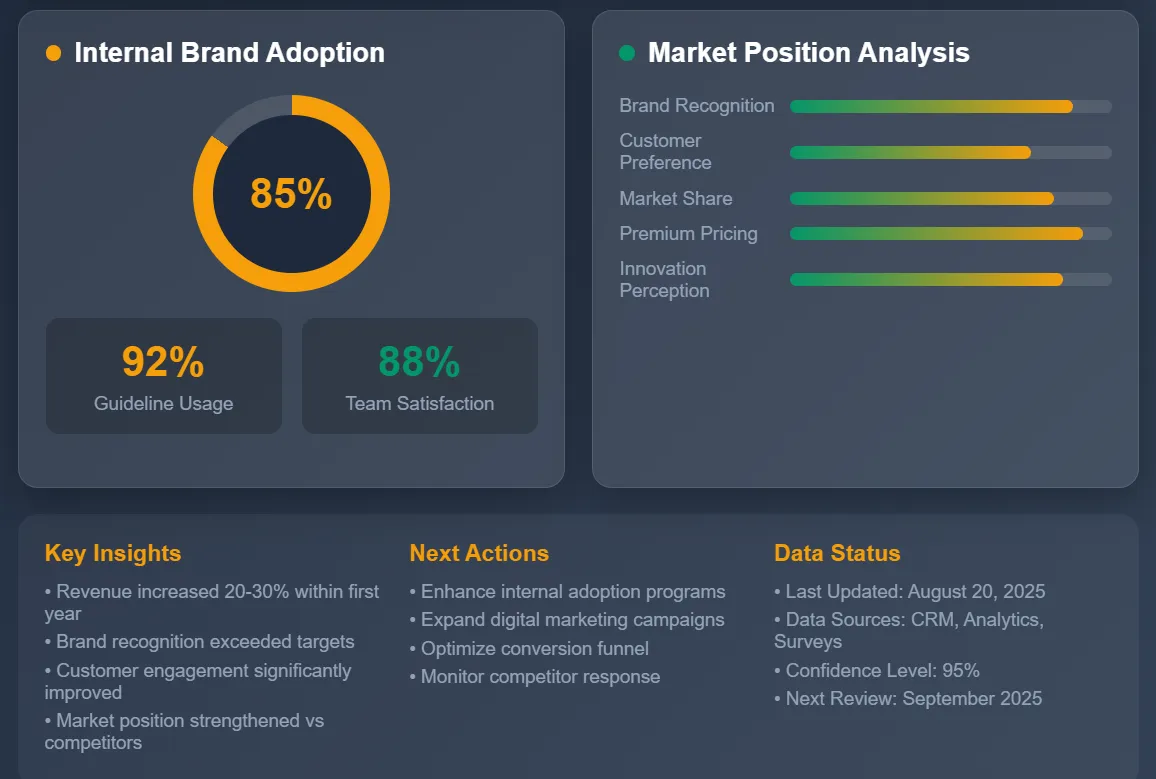
Managing Internal Change During Rebranding
Employee buy-in determines rebranding success beyond any external factor. Teams serve as brand ambassadors, and their authentic enthusiasm or skepticism directly influences customer perceptions and business results.
Start internal communications early in development processes. Share strategic reasoning behind rebranding decisions and involve key employees in development discussions. People who understand the "why" behind changes are significantly likely to support implementation efforts.
Training programs help employees understand new brand guidelines and messaging frameworks through hands-on workshops and practical exercises:
- Role-playing exercises prepare customer-facing staff for common questions about brand changes
- Brand guidelines workshops ensure consistent application across all touchpoints
- Messaging training helps teams communicate new positioning effectively
- Digital tool training ensures proper use of new brand assets and templates
Recognition programs reward employees who excel at representing new brands. Highlighting success stories creates positive momentum and encourages broader organizational adoption of new brand standards and behaviors.
Change management principles apply directly to rebranding projects. Expect resistance to changes, address concerns directly through open communication, and celebrate early wins to build confidence in new brand direction and strategic positioning.
Case Studies: Successful Rebranding Stories and Lessons Learned
Airbnb's Strategic Evolution

Airbnb transformed from a simple room-sharing service into a global hospitality platform through strategic rebranding. Their 2014 rebrand introduced the "Bélo" symbol and "Belong Anywhere" messaging, emphasizing community connection and belonging over transactional relationships.
The rebrand coincided with international expansion and new product launches across multiple market segments. By focusing on emotional connection rather than price competition, Airbnb differentiated itself from traditional hotels and vacation rental competitors.
Results included 30% increase in bookings within six months and successful expansion into 65,000+ cities worldwide. The strategic rebrand positioned Airbnb as a lifestyle choice rather than just accommodation, fundamentally changing market perception and competitive dynamics.
Dunkin's Bold Simplification

Dunkin' Donuts dropped "Donuts" from their name in 2018, signaling evolution into a beverage-focused brand. The rebrand reflected changing customer behavior patterns and increased competition in the expanding coffee market segment.
New store designs emphasized speed and convenience over traditional bakery atmospheres. Menu expansion included more beverage options and healthier food choices that aligned with changing consumer preferences and dietary trends.
The simplified brand helped Dunkin' compete effectively with Starbucks and local coffee shops. Same-store sales increased 2.4% in the following year, with beverage sales driving growth and profitability improvements.
{{vad-quote-3}}
Guide to Rebranding: Launch Strategy
Strategic launch timing maximizes impact while minimizing customer confusion and market disruption. Coordinate all touchpoint updates to create cohesive customer experiences from implementation day one.
Soft launches allow testing with limited audiences before full market rollouts. Beta customers, loyal clients, or specific geographic markets provide valuable feedback while reducing overall business risk and implementation costs.
The following rebranding steps optimize market impact:
- Internal team training and preparation.
- Key customer and partner notification.
- Soft launch with select audience segments.
- Full market launch with comprehensive marketing support.
- Follow-up communication and feedback collection.
Media relations help explain rebrand stories to key audiences through press releases, executive interviews, and industry publication features. These efforts create awareness and credibility for new brand positioning while managing potential confusion.
Customer communication sequences prepare audiences for changes through email campaigns, direct mail, and personal outreach from sales teams. These touchpoints maintain relationships during transitions and answer common questions proactively.
Digital coordination ensures consistent experiences across online touchpoints. Website updates, social media changes, and search marketing adjustments should happen simultaneously to prevent customer confusion and mixed messaging.
If you recognize your company in the scenarios described above and are ready for a strategic brand refresh, our rebranding services will help you navigate the entire process from analysis to successful launch. We specialize in comprehensive projects where every decision is based on a deep understanding of your business and market. Learn more - https://celerart.com/services/brand-identity/rebranding
Long-term Brand Management After Brand Update
Successful rebranding extends far beyond launch completion. Long-term brand management ensures investments continue generating business returns and competitive advantages.
Brand guidelines enforcement maintains consistency across all organizational touchpoints. Regular audits identify deviations from standards and provide opportunities for course correction before problems become widespread.
Employee education programs keep teams current on brand standards and messaging evolution. New hire orientations should include comprehensive brand training that covers history, positioning, and practical application guidelines.
Customer feedback monitoring helps identify perception changes and adaptation needs through regular surveys and social media listening. These insights provide early warning signs of brand drift or market perception shifts that require attention.
Performance measurement systems track rebranding ROI and identify optimization opportunities through monthly reports that include brand recognition metrics, customer acquisition costs, and revenue impact indicators.
Annual brand reviews assess competitive positioning and identify brands in need of rebranding as markets evolve continuously. Brands must adapt to maintain relevance while preserving core identity and market position.
{{vad-quote-4}}
Future-Proofing Your Brand: Staying Relevant Long-Term
Successful brands build adaptability into their foundational DNA. Design systems that can evolve without losing core identity help brands stay current across changing market conditions and consumer expectations.
Technology integration becomes increasingly important as digital experiences dominate customer interactions. Plan for emerging platforms and changing user behaviors that will reshape brand touchpoint requirements and customer experience expectations.
Sustainability considerations influence brand perception across all industries and demographic segments. Environmental and social responsibility should factor into long-term brand strategy development and positioning decisions.
Global market expansion requires flexible brand architectures that adapt to different cultural contexts while maintaining core identity recognition. This balance between local relevance and global consistency challenges many brands to rebrand.
Continuous customer research keeps organizations ahead of changing preferences and expectations through regular touchbase sessions with key customers that provide early insights into market shifts and competitive threats.
Your Rebranding Journey Starts Here
Rebranding represents one of the most impactful investments you can make in your business's future growth and competitive positioning. Strategic execution transforms how customers see you and how they engage with and value your offerings.
Companies that succeed in rebranding treat it as comprehensive business transformation, never just marketing projects. They involve teams, listen to customers, and commit to long-term brand management that sustains competitive advantages over time.
Your rebranding journey will be unique to your business context, market conditions, and strategic goals. Use this guide to rebranding as your roadmap, but remember that the best rebrands combine strategic thinking with authentic storytelling and flawless tactical execution.
Professional rebranding investment pays dividends through increased customer loyalty, premium pricing ability, and competitive differentiation. In today's crowded marketplace, a strong, well-positioned brand isn't just a business asset – it's a necessity for sustainable growth and market leadership.












